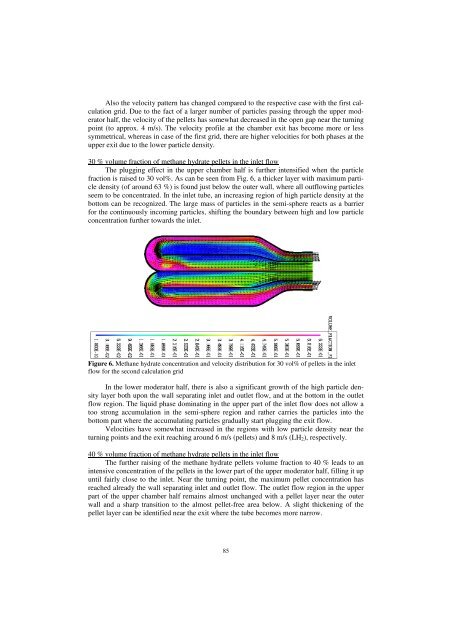Druck-Materie 20b.qxd - JUWEL - Forschungszentrum Jülich
Druck-Materie 20b.qxd - JUWEL - Forschungszentrum Jülich
Druck-Materie 20b.qxd - JUWEL - Forschungszentrum Jülich
Create successful ePaper yourself
Turn your PDF publications into a flip-book with our unique Google optimized e-Paper software.
Also the velocity pattern has changed compared to the respective case with the first calculation<br />
grid. Due to the fact of a larger number of particles passing through the upper moderator<br />
half, the velocity of the pellets has somewhat decreased in the open gap near the turning<br />
point (to approx. 4 m/s). The velocity profile at the chamber exit has become more or less<br />
symmetrical, whereas in case of the first grid, there are higher velocities for both phases at the<br />
upper exit due to the lower particle density.<br />
30 % volume fraction of methane hydrate pellets in the inlet flow<br />
The plugging effect in the upper chamber half is further intensified when the particle<br />
fraction is raised to 30 vol%. As can be seen from Fig. 6, a thicker layer with maximum particle<br />
density (of around 63 %) is found just below the outer wall, where all outflowing particles<br />
seem to be concentrated. In the inlet tube, an increasing region of high particle density at the<br />
bottom can be recognized. The large mass of particles in the semi-sphere reacts as a barrier<br />
for the continuously incoming particles, shifting the boundary between high and low particle<br />
concentration further towards the inlet.<br />
Figure 6. Methane hydrate concentration and velocity distribution for 30 vol% of pellets in the inlet<br />
flow for the second calculation grid<br />
In the lower moderator half, there is also a significant growth of the high particle density<br />
layer both upon the wall separating inlet and outlet flow, and at the bottom in the outlet<br />
flow region. The liquid phase dominating in the upper part of the inlet flow does not allow a<br />
too strong accumulation in the semi-sphere region and rather carries the particles into the<br />
bottom part where the accumulating particles gradually start plugging the exit flow.<br />
Velocities have somewhat increased in the regions with low particle density near the<br />
turning points and the exit reaching around 6 m/s (pellets) and 8 m/s (LH2), respectively.<br />
40 % volume fraction of methane hydrate pellets in the inlet flow<br />
The further raising of the methane hydrate pellets volume fraction to 40 % leads to an<br />
intensive concentration of the pellets in the lower part of the upper moderator half, filling it up<br />
until fairly close to the inlet. Near the turning point, the maximum pellet concentration has<br />
reached already the wall separating inlet and outlet flow. The outlet flow region in the upper<br />
part of the upper chamber half remains almost unchanged with a pellet layer near the outer<br />
wall and a sharp transition to the almost pellet-free area below. A slight thickening of the<br />
pellet layer can be identified near the exit where the tube becomes more narrow.<br />
85

















